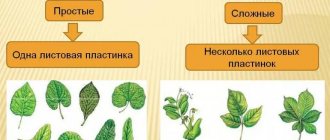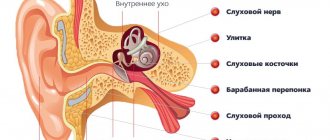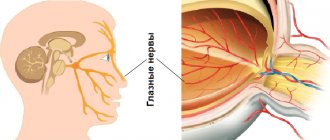Types of plant buds
A bud in plants is an embryonic shoot. A vegetative bud has a rudimentary stem with a growth cone and rudimentary leaves. The flower bud contains the embryonic flowers. The outside of the buds is covered with bud scales. After a period of rest, the buds open. The expansion of shoots from the buds is associated with the growth of internodes and leaves.
Apical bud
At the top of the shoot there is usually an apical bud.
Lateral bud (axillary)
The lateral (axillary) buds are located in the axils of the leaves. Axillary buds are located on the stem alternately (willow, linden, alder, aspen) or opposite (elderberry, maple, lilac, ash) (Fig. 113).
Accessory buds
Sometimes buds may develop not in the leaf axil, but on the internodes of the stem, roots or leaves. Such buds are called accessory buds.
Overwintering buds
In temperate latitudes in mid-summer or autumn, in the tropics with the onset of the dry period, the apical and axillary buds enter seasonal dormancy. In temperate latitudes, such buds are called hibernating or dormant. The outer leaves of these buds turn into dense covering bud scales, almost hermetically covering the inner parts of the bud. Covering scales reduce the evaporation of water from the surface of the internal parts of the buds, and also protect the buds from freezing, pecking by birds, etc.
Dormant buds
Not all buds laid in the previous year bloom on trees and shrubs. Many axillary buds remain dormant for a long time, sometimes many years. Such buds are called dormant (Fig. 116). In oak they “sleep” for up to 100 years, in birch - up to 50, in aspen - 40, in honeysuckle - 35, in hawthorn - up to 25 years.
When the apical bud disappears (due to freezing, biting, pruning), the dormant buds begin to grow and grow into elongated shoots. Especially often such shoots develop on oak, elm, maple, rowan, poplar, and apple trees.
Dormant buds are of great importance for restoring the crown when it is damaged by spring frosts and during decorative pruning of trees and shrubs. In cities, the crowns of poplars are often severely pruned, leaving only the trunk or several large side branches. In spring, many young shoots appear on the pruned parts of the tree, which develop from dormant buds (Fig. 117).
Dormant buds remain alive for many years
A bud is a greatly shortened shoot with rudimentary leaves or reproductive organs. The buds can be vegetative, having shoot and leaf buds; generative, bearing the primordia of a flower or inflorescence, mixed. Based on their location, they distinguish between apical buds (at the end of the shoot) and axillary buds (at the nodes between the leaf petiole and the stem).
According to their functional significance, dormant buds are distinguished, which do not bloom annually and remain alive for many years. And they wake up when the upper part of the stem is removed. From them shoots are formed. Adventitious buds are formed inside stems, leaves, and roots from cells of various tissues and provide vegetative propagation. Dormant buds are formed on those organs that do not die off during the winter or during periods of drought. They require a period of rest, then they ensure the perennial existence of woody or herbaceous plants.
Adventitious buds are characteristic of a few species, for example, elm and hornbeam. They are formed by the cambium at the cutting site after cutting, wounding or functional disturbances of trunks or roots. The quality and quantity of shoots formed from dormant buds significantly exceeds shoots formed from adventitious buds.
Dormant buds are formed by a woody plant at an early age, as well as at a later time during the formation of the annual ring, and can develop for decades without “waking up,” branching out and leaving traces of their growth in the wood of the trunk (Fig. 17). Moreover, they remain near or on the surface of the bark throughout the life of the tree.
Rice. 17. Branched dormant buds of Philadelphus coronarius
Dormant buds wake up in crisis situations: with a sharp disruption in the life of trees due to damage to the crown, trunk, as well as with a lack of basic environmental factors - light, moisture. Thus, the oak undergrowth under the canopy, in conditions of lack of light, acquires a bushy shape, the so-called “sticky” shape. The death or weakening of the growth of the axial (terminal) shoot due to lack of light causes the appearance of new shoots from dormant buds on the stem or on the root collar. In this form, oak regrowth can exist on rich, moisture-provided soils under shading conditions for up to 17 years
Dormant buds wake up when there is significant damage to tree crowns or death of their above-ground parts. Thus, record low air temperatures of -51.1°C (weather station in Morki, RME) in the Middle Volga region were observed on December 31 and January 1, 1978/79. The result was severe damage and death to the crowns of heat-loving species: pedunculate oak, Norway maple, and small-leaved linden. The old oak trees died. The young survived by forming a secondary crown from dormant buds. Some of the trees sprouted shoots from the root collar.
Ground fires can lead deciduous forest stands to death, but at the same time, the remaining dormant buds on the root collar buried in the soil (most deciduous) and on the roots (aspen, less often birch) provide the possibility of rapid restoration of trees and forest stands as a whole. The regeneration of birch forests in the Middle Volga region, which were affected by ground fires during the severe drought of 1972, was ensured precisely due to dormant buds
Structure of plant buds
Based on their structure, buds are distinguished between vegetative and generative (floral).
Vegetative bud
A vegetative bud consists of a rudimentary stem and rudimentary leaves located on it. Tiny rudimentary axillary buds can be found in the leaf axils. On the outside, the buds are protected by bud scales. Material from the site https://wiki-med.com
Inside the bud at the top of the stem there is a growth cone consisting of cells of the apical educational tissue. Thanks to the division, growth and change of its cells, the stem grows, new leaves and buds are formed (Fig. 114).
Generative bud (floral)
In the generative (floral) buds on the stem, in addition to the rudimentary leaves, there are the rudiments of flowers or one flower. This is clearly visible in elderberry (see Fig. 114) and chestnut. lilac. The generative buds of many woody plants differ from the vegetative ones in size and shape: they are larger and often rounded.
By what criteria are kidneys divided?
The kidneys are divided according to several characteristics and have corresponding names:
- According to location on the plant body. The apex is a terminal bud, the leaf axils are axillary, and the remaining parts of the plant are adventitious. Both axillary and accessory buds are classified as lateral buds.
- According to content and functions - vegetative, generative and mixed.
- By structure - closed and open (bare).
- According to their involvement in the development of plants, they are active, dormant, and also buds of renewal.
Structure and types of kidneys
Types of macro- and microscopic structure of the stem
1. Shoot - part of the stem that has grown in one growing season along with the leaves and buds located on it. This is an organ that arises from the apical meristem and is divided at an early stage of morphogenesis into specialized parts: stem, leaves, buds.
Its main function is photosynthesis.
Parts of the shoot can also serve for vegetative propagation, accumulation of reserve products and water.
The section of the stem at the level of the leaf origin is called a node, and the section of the stem between two nodes is called an internode.
The angle between the leaf petiole and the stem is called the leaf axil .
An axillary bud is formed above the node in the leaf axil .
Closed node - a leaf or whorl of leaves completely surrounds the stem with its bases.
Open node - bears a leaf that does not completely enclose the stem.
Is it possible and necessary to awaken them?
An emerging bud that has frozen during development is called dormant.
The process of propagation of indoor orchids consists of obtaining a baby from a dormant bud. For some varieties, for example, phalaenopsis, vanda is the only way to produce offspring. In the wild, the buds wake up with the onset of the rainy season .
An exotic flower accumulates moisture, absorbs nutrients and gains strength to create offspring. In order for the kidneys to awaken at home, it is necessary to create the same microclimate.
Stem
The stem is the main structural part of the shoot, consisting of nodes and internodes.
The stem has the following functions:
- conductive - ascending and descending currents of substances move between the roots and leaves in the stem.
- mechanical (supporting) - carries leaves, buds, flowers and fruits.
- assimilation - the green part of the stem is capable of performing the function of photosynthesis.
- storage of nutrients and water.
The stem is usually cylindrical in shape and is characterized by radial symmetry in the arrangement of tissues.
However, in cross section it can be not only round
, but also
angular
,
three-
,
four-
or
multifaceted
,
ribbed
,
grooved
, sometimes completely flat,
flattened
, or bearing protruding flat ribs -
winged.
Types of stems by cross-sectional shape : 1 – round; 2 – flattened; 3 – triangular; 4 – tetrahedral; 5 – multifaceted; 6 – ribbed; 7 – grooved; 8, 9 – winged.
Types of stems by position in space: 1 – erect; 2 – rising; 3 – creeping; 4 – creeping; 5 – curly; 6 – climbing (clinging).
Branching of shoots
Branching is the process of formation of new shoots and the nature of their relative arrangement on the stem, perennial branches and rhizome.
Since the shoot is an axial organ, it has an apical meristem, which ensures unlimited growth in length.
Such growth is accompanied by more or less regular branching of the shoot. In lower plants, as a result of branching, a branched thallus (thallus) appears, in higher plants, systems of shoots and roots are formed. Branching allows you to repeatedly increase the photosynthetic surface and provide the plant with organic substances.
Several types of branching are observed in different plants: dichotomous , monopodial , sympodial .
With dichotomous branching, the growth cone is split in two (mosses).
Dichotomous branching is the most primitive type of branching, observed as in lower plants
, and in some higher plants (for example, in
Bryophyta, Lycopodiophyta, some Pteridophyta
).
With dichotomous branching, the growth cone is divided in two, the newly formed apexes are also divided in two, and so on.
There are so-called isotomic dichotomous branching (the resulting branches are equal in size) and anisotomic (in which the resulting branches are unequal)
With monopodial branching, the apical bud functions throughout life, forming the main shoot (first-order axis), on which second-order axes develop in acropetal sequence, third-order axes on them, etc. (gymnosperms - spruce, pine)
Monopodial branching is the next stage in the evolution of shoot branching. In plants with a monopodial type of shoot structure, the apical bud is retained throughout the life of the shoot.
Monopodial branching is common among gymnosperms and is also found in many angiosperms (for example, many species of palms
, as well as plants from
the Orchid family
-
gastrochilus, phalaenopsis and others
). Some of them have a single vegetative shoot (for example, Phalaenopsis pleasant).
Monopodial plants are the term most often used in describing plants of tropical and subtropical flora, as well as in popular scientific literature on indoor and greenhouse floriculture.
Monopodial plants can vary significantly in appearance. Among them there are rosettes, with elongated shoots, and bush-like ones.
With sympodial branching, one of the upper axillary buds forms a second-order axis, which grows in the same direction as the first-order axis, displacing its dying part to the side.
This division was first proposed by the German botanist Pfitzer at the end of the 19th century.
In plants with a sympodial type of shoot structure, the apical bud, having completed development, dies or gives rise to a generative shoot.
After flowering, this shoot no longer grows, and a new one begins to develop at its base. The shoot structure of plants with a sympodial type of branching is more complex than that of plants with a monopodial type; sympodial branching is an evolutionarily more advanced type of branching. The word “sympodial” is derived from ancient Greek. συν- (“together”) and πούς (“leg”).
Plant buds
Sympodial branching is characteristic of many angiosperms: for example, lindens, willows and many orchids
.
Sympodial plants are the term most often used in describing plants of tropical and subtropical flora, as well as in popular scientific literature on indoor and greenhouse floriculture.
In the first stages of evolution, the apical meristems of both branches of each fork grow at the same rate, which leads to the formation of identical or almost identical daughter branches.
Such equal dichotomy (isotomy) represents the original type of dichotomous branching. It was characteristic of some rhyniophytes, but is also found in some modern lycophytes and pteridophytes, as well as in Psilotum.
As a result of the unequal growth of the two daughter branches, when one of the branches is somewhat ahead of the other, the equal dichotomy turns into an unequal dichotomy (anisotomy), very well expressed in the primitive extinct Devonian genus Horneophyton.
Types of shoot branching (according to L.I. Lotova):
A – dichotomous (moss);
B – monopodial (spruce, leaves removed);
B – sympodial (birch);
I-III – serial numbers of increments;
1 – apical bud; 2 – lateral buds; 3 – dead upper parts of shoots.
Kidney classification
Kidneys are classified according to:
Location on the shoot: apical (terminal) and lateral .
A shoot of the first order (main shoot) develops from the apical shoots, and shoots of the second, third, fourth, etc., that is, lateral shoots, develop from the lateral shoots.
2. Origin: there are axillary and extra-axillary. Axillaries are located in the leaf axil and are formed exogenously (in the form of tubercles).
Οʜᴎ are single (located singly in the leaf axil) and grouped (several pieces). Groups can be serial (several buds are located above each other) and collateral (located nearby).
Extra-axillary buds are located on the internodes and are formed on an already formed shoot endogenously (from the cambium, pericycle, phellogen, phloem parenchyma).
Brood buds are those buds that sprout into a small plant that falls away from the mother plant and begins an independent existence ( bryophyllum ).
Rice. 81. Lilac branch:
A – general view, B – shoot tip, C – buds (longitudinal section):
1 – lateral bud, 2 – leaf scar, 3 – annual growth limit
4 – bud scales, 5 – rudimentary inflorescence, 6 – growth cone.
3. According to their significance in life, plants are classified into:
- dormant buds - formed at the end of the growing season and at rest tolerate unfavorable conditions (cold, heat), and with the onset of favorable conditions they give rise to shoot growth;
- enrichment bud, which gives growth immediately after initiation, during the same growing season, forming enrichment shoots (increase the photosynthetic surface);
— dormant buds that, having become established, do not begin to grow for a number of years.
Such a bud annually forms a certain number of metamers; they are always located on the surface of the stem. When pruning and aging of the shoot system, they give growth and restore the shoot system of plants.
Based on their structural features, they are classified into:
- vegetative, consisting of a rudimentary stem and rudimentary leaves;
- vegetative-generative, in addition to the rudimentary stem and leaves, contain the rudiments of inflorescences and flowers;
- generative - contain the rudiments of inflorescences and flowers;
- closed, which are covered with dense kidney scales;
- open, without dense kidney scales.
Dormant buds
However, in the spring, not all the buds on the shoots laid in the previous year bloom each year; some become dormant.
When frosting, biting, or cutting off part of the tree crown, dormant buds begin to grow and form shoots, which are called tops . Due to them, trees are restored when damaged by frost or pests. There are especially many dormant buds at the base of the trunk.
Questions about this material:
What is a kidney?
What types of kidneys are there?
Escape structure
The organism of a flowering plant is a system of roots and shoots. The main function of above-ground shoots is to create organic substances from carbon dioxide and water using solar energy. This process is called air feeding of plants.
A shoot is a complex organ consisting of a stem, leaves, and buds formed during one summer.
The main shoot is the shoot that develops from the bud of the seed embryo.
Lateral shoot is a shoot that appears from a lateral axillary bud, due to which the stem branches.
An elongated shoot is a shoot with elongated internodes.
Shortened shoot - a shoot with shortened internodes.
A vegetative shoot is a shoot that bears leaves and buds.
Generative shoot - a shoot bearing reproductive organs - flowers, then fruits and seeds.
So what kind of care do frozen trees need?
As usual, this is a whole range of events. First of all, it is necessary to create a high agricultural background - ensure good soil maintenance, fertilization, watering, pruning the crown, fighting diseases and pests (especially those that damage leaves). Only compliance with these seemingly ordinary measures can guarantee quick and effective restoration of frozen trees.
In early spring, before the buds open, it is necessary to whitewash the trunks and bases of skeletal branches with lime. A little later, plow or loosen the soil and apply fertilizer (if all this is not done in the fall). After flowering, do not forget to give the trees foliar feeding with ammonium nitrate (3-4 g per 1 liter of water). If the soil moisture is insufficient (if the autumn in your area was dry or the winter had little snow), it is necessary to water before flowering, this will promote the growth of roots and shoots.
One of the most important techniques for restoring frozen trees is pruning.
If only the ends of the branches are slightly frozen, pruning is carried out in the spring before the beginning of the growing season according to the type of regular pruning (that is, shortening and thinning).
If the plants are more frozen (the tissues of the buds and shoots have darkened), you should not rush into pruning. In this case, expect the buds to awaken and shoots to begin to grow. Pruning is carried out according to the rejuvenating type: branches are greatly shortened to healthy growing shoots, obviously dead parts.
The branches are cut off and transferred to living lateral branches. Skeletal branches are shortened to 3-5 year old wood. After such pruning, new shoots, tops, appear from the dormant buds, from which a new crown is subsequently formed. After pruning, the bark of the trunk and main branches is tied with burlap or matting to protect it from drying out. Pear, apple, apricot and peach trees lend themselves well to rejuvenation; plums, cherries and cherries are worse. If the trunks of fruit trees are damaged by frost, as often happens, there is also a way out. In this case, root grafting is carried out using the bridge method. And the frost hole needs to be cleaned and covered with garden varnish or nigrolic putty. You can also use clay putty with mullein.







